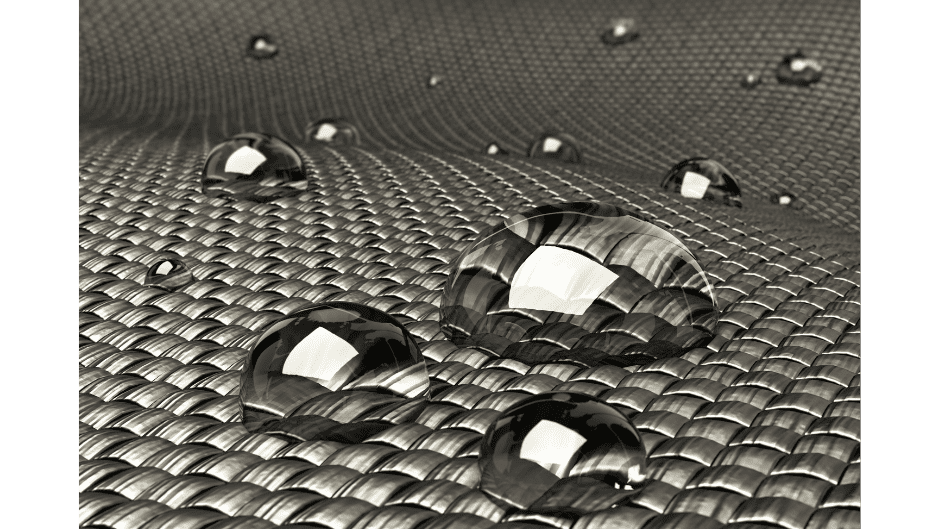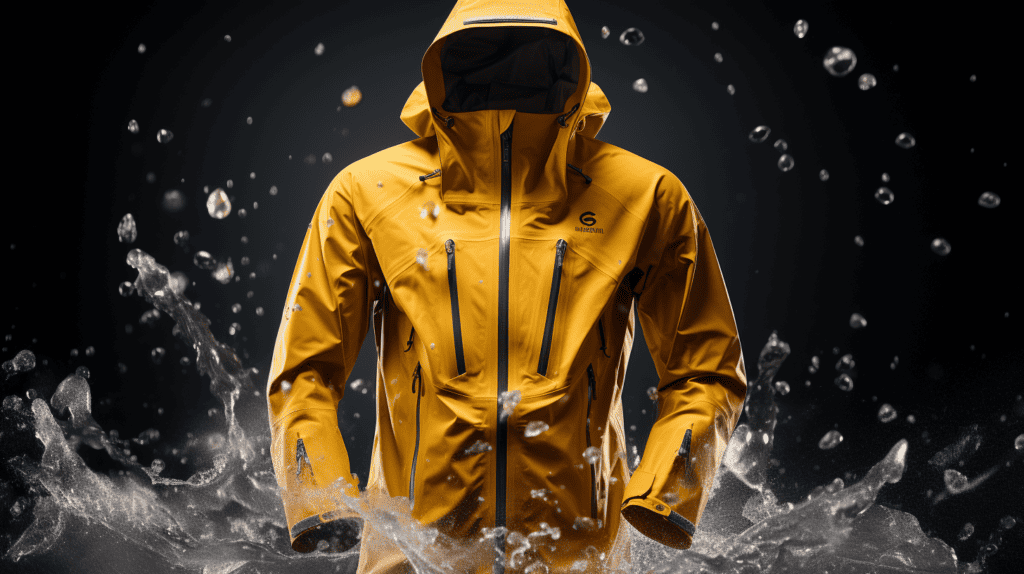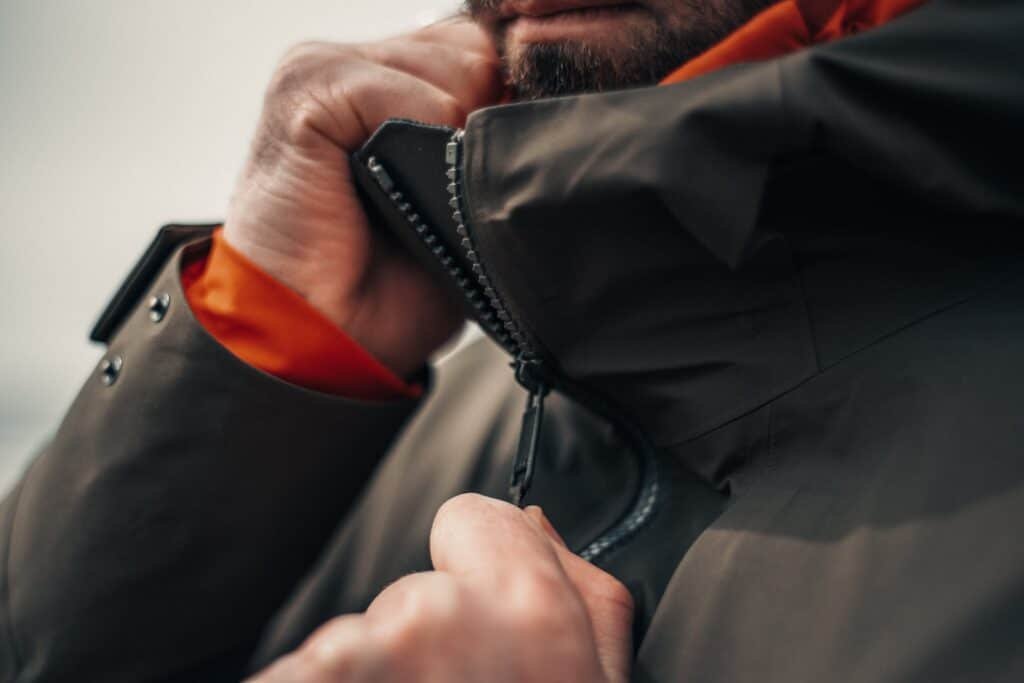Understanding Waterproofing Rating and Breathability | A Comprehensive Guide

Ever found yourself in a downpour, only to realize your “waterproof” jacket isn’t living up to its promise? Understanding waterproof and breathability ratings, including the waterproofing rating, can save you from soggy and uncomfortable situations.
In this comprehensive guide, we’ll dive into the world of waterproof ratings, the science behind them, and how to choose the perfect jacket for your needs with the right waterproofing rating.
Key Takeaways
Understanding waterproof ratings is essential for selecting the right jacket.
Layered jackets are ideal for fluctuating weather conditions, offering adjustable protection & breathability.
Look for a good balance of water resistance, ventilation features, and fit to ensure dryness & comfort in any weather condition.
Understanding Waterproof Ratings

Waterproof ratings serve as a key determinant of a jacket’s resistance to water. They help you pick the right shoes or jacket for various activities and conditions by providing a measurement of how much water pressure the fabric can withstand before leaking.
Staying dry and comfortable in various weather conditions, from a light drizzle to a torrential downpour, depends on the knowledge of your jacket’s waterproof rating.
Everyday Use (1,500mm to 2,000mm)
Jackets with a waterproof rating of 1,500mm to 2,000mm are designed for everyday use and light outdoor activities. Picture yourself going for a morning jog or grabbing a coffee on a drizzly day; these ratings are perfect for such occasions. Jackets in this range often feature eVent and Pertex Shield technology, providing lightweight, breathable outerwear with a waterproof lining for enhanced comfort.
Yet, these jackets might not offer complete dryness during heavy rain or long durations of wet weather. Their primary purpose is to shield you from light rain and occasional drizzle, providing just enough protection without sacrificing breathability.
All-weather protection (5,000mm to 10,000mm)
If you’re the type of person who doesn’t let a little rain dictate your plans, mid-range waterproof ratings (5,000mm to 10,000mm) are your ideal choice. These jackets are designed to handle moderate to heavy rain, offering a higher level of water resistance thanks to their durable water-repellency coating. Popular brands like Gore-Tex, eVent, and Pertex have jackets in this range that provide excellent all-weather protection.
A 5,000mm waterproof rating hits the sweet spot for outdoor enthusiasts like skiers and snowboarders, providing an optimum balance of waterproof breathability in cold, clear conditions. In short, mid-range ratings are perfect for those who require reliable protection from wet conditions without sacrificing comfort.
Extreme Conditions (20,000mm+)
For adventurers who laugh in the face of storms, jackets with a 20,000 mm+ waterproof rating are designed to withstand extreme conditions. These waterproof gear options are not only highly water-resistant but also provide excellent protection against wet snow and prolonged rain. They are often made from robust materials like Gore-Tex Pro and eVent, which are specifically designed to handle harsh weather conditions.
A high waterproof rating is particularly important for backcountry skiers, snowboarders, and those venturing into wetter climates. By investing in a 3-layer jacket with extra waterproofing and a tough face fabric, you’ll be well-prepared for any weather conditions that come your way.
The Science Behind Waterproof Ratings

A range of tests and standards, including the Hydrostatic Head Test and the British Standard, establish waterproof ratings. These tests measure a fabric’s water resistance, giving you an idea of how much rainfall a jacket can handle in a single day.
Grasping these tests is important as they set the industry benchmark to compare different waterproof fabrics’ performance.
Hydrostatic Head Test
The Hydrostatic Head Test plays a vital role in establishing a fabric’s resistance to water. It involves pulling the fabric tight under a sealed tube of water and observing how many millimeters of water it can handle before soaking through over a 24-hour period. The resulting measurement, known as the hydrostatic head, is expressed in millimeters and gives you a clear indication of a fabric’s waterproof performance.
The higher the hydrostatic head, the more waterproof the fabric is considered to be. For example, a fabric with a hydrostatic head of 5,000mm can withstand 5,000mm of water pressure before it starts to leak. This test is performed multiple times on various fabrics, and the scores are averaged to determine the final waterproof rating.
British Standard
The British Standard for waterproofing is considered the “Gold Standard” in the industry, ensuring that waterproof products meet the highest quality standards. It is a strict and thorough standard that guarantees a high level of water resistance and breathability in the products that adhere to it.
Products with the British Standard for waterproofing offer a reliable and durable performance, giving you superior protection against water and other elements. By opting for a fully waterproof jacket that meets the British Standard, you can trust that you’re investing in a product that has been rigorously tested and approved for its waterproof capabilities.
Waterproof vs. Water-Resistant Jackets

Distinguishing between waterproof and water-resistant jackets is crucial when choosing a jacket. While water-resistant fabrics can handle light rain and drizzle, they are not designed to withstand heavy rain or snow. On the other hand, waterproof materials offer a higher level of water resistance, making them suitable for more demanding weather conditions.
Understanding the distinction between these two jacket types can guide you in selecting the perfect jacket for your needs.
Waterproof Coating
The performance of a jacket significantly depends on waterproof coatings. These coatings, such as Durable Water Repellent (DWR) and membrane coatings, prevent water from penetrating the fabric, ensuring that you stay dry even in heavy rain. As technology continues to advance, so does the effectiveness of waterproof coatings, providing even better protection against the elements.
However, bear in mind that there can be considerable variation in the quality of waterproof coatings. Some jackets may have a similar water-repellent coating, but their overall waterproof performance can vary significantly. When choosing a waterproof jacket, it’s essential to consider the type of waterproof coating used, as well as its durability and effectiveness.
Taped Seams
Taped seams, which prevent leaks and enhance overall water resistance, are a crucial feature in waterproof jackets. Seam sealing, also known as heat sealing, involves using waterproof tape to cover the tiny holes created by the needle during the sewing process. This prevents water from entering the jacket through these vulnerable points.
When selecting a waterproof jacket, it’s crucial to look for one with fully taped seams, as this ensures that the jacket is completely waterproof. Jackets with only partially taped seams may still allow water to seep through in certain areas, compromising the overall water resistance of the garment.
Choosing the Right Waterproof Jacket

Choosing the ideal waterproof jacket entails factors like layering, multi-functionality, and personal preferences. By understanding the different waterproof ratings, as well as the importance of breathability and other features, you can make an informed decision and find the perfect jacket for your needs.
In the following sections, we’ll explore different types of jackets and how to choose the right one for you.
Layered Jackets
Layered jackets offer versatility and adaptability for fluctuating weather conditions. These jackets usually consist of an outer layer, a waterproof membrane, and a fully bonded inner layer. They provide excellent protection from the elements and can be easily adjusted to suit different weather conditions, making them the ideal choice for those who need a versatile, all-weather option.
When selecting a layered jacket, consider the waterproof rating of the outer layer and how it will perform in various conditions. Additionally, think about the type of activity you’ll be doing and ensure that the jacket offers enough breathability to keep you comfortable throughout your adventure.
Multi-Functional Jackets
Multi-functional jackets provide more than just water resistance, offering additional features for enhanced utility and effectiveness. These jackets often come with adjustable hoods, pockets, and ventilation systems, ensuring that you stay comfortable and protected in a wide range of weather conditions.
When choosing a multi-functional jacket, consider the types of activities you’ll be doing and the climate you’ll be in. Opt for a jacket that not only offers excellent water resistance but also provides the additional features and functionalities that you need for your adventures.
Breathability in Waterproof Jackets

Breathability, a crucial factor in waterproof jackets, guarantees comfort and curbs moisture buildup. A jacket’s breathability rating measures the amount of water vapor that can pass through the fabric, which is crucial for maintaining comfort during physical activities or in humid climates.
In the following sections, we’ll explore different waterproof and breathability ratings, as well as ventilation features in waterproof breathable outerwear, such as waterproof jackets.
Breathability Ratings
Breathability ratings help determine the ideal balance between water resistance and breathability in a jacket. These ratings measure how much moisture, by weight, can pass through a square meter of fabric in 24 hours. By understanding breathability ratings and their correlation with waterproof ratings, you can find the perfect jacket that offers the right balance of protection and comfort.
For example, a jacket with a high waterproof rating but a low breathability rating may be suitable for heavy rain but could leave you feeling clammy and uncomfortable during physical activities. On the other hand, a jacket with a lower waterproof rating but a high breathability rating may be more suitable for light rain and physical activities, allowing moisture to escape and keeping you comfortable.
Ventilation Features
Ventilation features, such as zippered underarm vents and mesh-lined pockets, can significantly enhance a jacket’s breathability and overall comfort. These features allow air to flow through the jacket, reducing moisture and sweat buildup and ensuring that you stay dry and comfortable during physical activities or in humid climates.
When selecting a waterproof jacket, it’s essential to consider the following features:
Breathability: A jacket with excellent water resistance but poor ventilation may not be the most comfortable or practical option for your needs.
Ventilation: Look for jackets that offer ventilation features to help regulate your body temperature and prevent overheating.
Water resistance: Ensure that the jacket has a high level of water resistance to keep you dry in various weather conditions.
By choosing a jacket with the right combination of water resistance and ventilation features, you can ensure that you stay dry and comfortable in various weather conditions.
Finding the Perfect Fit

A perfect fit for your waterproof jacket is critical to ensure optimum performance and comfort. The right fit ensures that the jacket provides adequate protection from the elements while allowing for freedom of movement and the ability to layer clothing underneath.
In the following sections, we’ll provide sizing tips and layering considerations to help you find the perfect fit for your waterproof jacket.
Sizing Tips
Sizing guidelines and charts can assist in determining the ideal size for your waterproof jacket, thereby ensuring a proper fit and avoiding common pitfalls. It’s essential to consider the layers you’ll be wearing underneath the jacket, as well as the activity you’ll be participating in when selecting the right size. A jacket that’s too tight may restrict movement and hinder breathability, while a jacket that’s too loose may not provide adequate protection from the elements.
When trying on a waterproof jacket, ensure that:
You can move your arms and shoulders freely
There’s enough room for any additional layers you may need to wear underneath
The cuffs are long enough to cover the top of your hand to prevent water from seeping in
Layering Considerations
When selecting a waterproof jacket, layering is a vital consideration influencing your choice of jacket size and type. When layering, it’s important to opt for lightweight, breathable, and moisture-wicking fabrics to ensure maximum comfort and performance. Additionally, the fabrics you choose should not be too bulky, as this can reduce the breathability of the jacket and cause discomfort.
Some ideal fabrics for layering with waterproof jackets include Gore-Tex Pro and eVent, which are renowned for their durability, waterproofing, and breathability. By considering the type of activity you’ll be participating in and the climate you’ll be in, you can select the right combination of layers to wear underneath your waterproof jacket for optimal comfort and protection.
Summary
Understanding waterproof and breathability ratings is crucial for choosing the perfect jacket to keep you dry and comfortable in various weather conditions. By considering factors such as layering, multi-functionality, and personal preferences, you can select the ideal jacket for your needs. Remember to pay attention to the science behind waterproof ratings, the importance of breathability, and the various features that enhance a jacket’s performance. Choose smart, stay dry, and enjoy your outdoor adventures knowing that you’re well-protected and comfortable in your waterproof jacket.
Frequently Asked Questions
What is a good waterproofing rating?
For avid skiers and snowboarders, the best waterproof rating is between 10,000mm and 20,000mm or higher – ensuring you can withstand any weather conditions out on the slopes. Going for the highest rating is a good idea.
What does 20k waterproofing mean?
A 20k waterproof rating ensures that the garment can withstand 20,000mm of pressure. This makes it highly waterproof, and it also provides 10,000 grams of breathability per square meter in a 24-hour period.
What does 5000 waterproofing mean?
5000mm waterproofing means you can stay out in the rain until 5,000mm of it has fallen before getting wet. It also refers to how breathable the coat is.
What is the PSI rating for waterproofing?
Most waterproof fabrics, including Gore-Tex, have a minimum PSI rating of 40 for full waterproofing according to British Standard.
What is the difference between waterproof and water-resistant jackets?
Waterproof jackets offer superior protection from rain and snow, while water-resistant jackets are designed for lighter weather conditions like drizzle and light rain.







